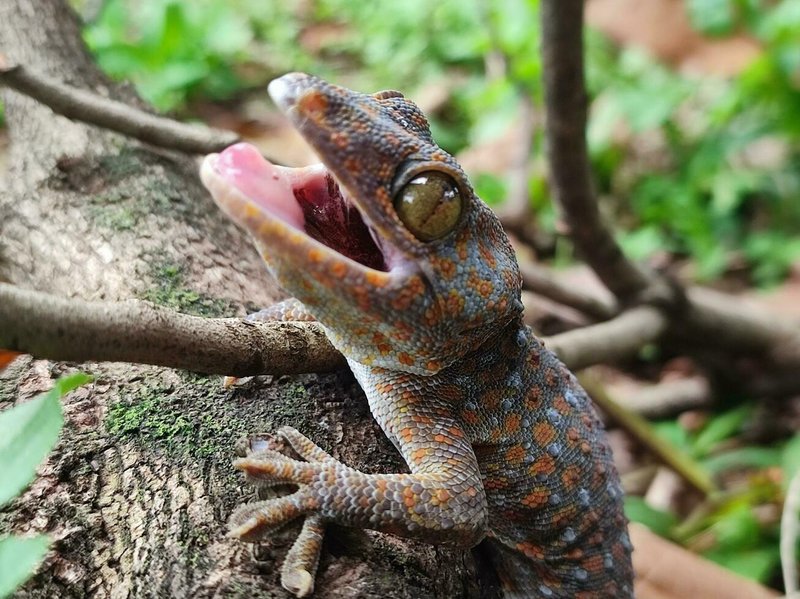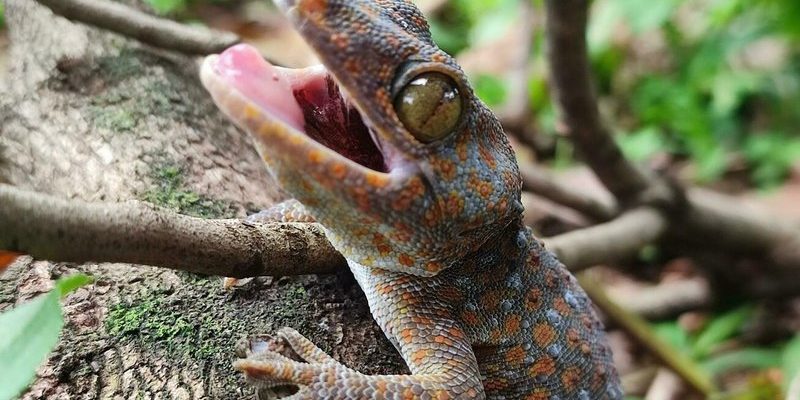
Have you ever watched a gecko scurry up a wall or across a ceiling? These remarkable little lizards are not just cute; they’re full of surprises! Found in warm climates around the world, geckos are known for their vibrant colors and unique behaviors. With over 1,500 species, they come in various shapes and sizes, each with its own charming quirks. Whether you’re a budding reptile enthusiast or just curious, there’s much to learn about these captivating creatures.
Geckos have some special traits that set them apart from other lizards. For starters, most gecko species are nocturnal, which means they are active at night. This adaptation helps them avoid predators and makes hunting easier in the dark. You might also notice that they have soft toes equipped with tiny hair-like structures, allowing them to climb smooth surfaces effortlessly. So, let’s take a closer look at their lives, habitats, and what makes geckos truly enchanting.
Physical Characteristics of Geckos
Geckos come in a splendid array of colors and patterns. Some are bright green, while others sport dazzling blue, orange, or even pink hues. The colors often serve as camouflage in their natural habitats, helping them hide from predators. It’s like nature’s own art gallery! Many species also change color based on temperature or mood, adding to their mystique.
In terms of size, geckos can vary dramatically. The tiny *Sphaerodactylus parthenopion*, known as the world’s smallest lizard, measures just around an inch long. On the other hand, the *Mourning Gecko*, which can reach lengths of up to a foot, showcases the vast diversity within this family. Their body structure is designed for agility, with long tails that can regenerate if lost. This defense mechanism is like having a built-in escape plan!
Habitat and Distribution
You’ll find geckos in a variety of habitats, from tropical rainforests to arid deserts. They thrive in warm climates, with the majority residing in regions like Southeast Asia, Africa, and Central America. Some species are even adapted to urban environments, making homes in backyards or inside houses. Have you ever noticed a little gecko peering at you from a corner? It’s quite common!
Geckos are incredibly adaptable. They can often be found in trees, on rocks, or even burrowed in the ground. Their choice of habitat typically depends on their species, with some favoring humid areas while others prefer drier conditions. Regardless of their specific needs, geckos play an essential role in their ecosystems as both predators and prey.
Diet and Feeding Habits
Geckos are primarily insectivores, which means their diet mainly consists of insects. Crickets, moths, and beetles are their favorite snacks. However, some species are known to be omnivorous, munching on fruit or plant matter as well. Imagine a little gecko darting out from its hiding spot to catch a passing bug—nature at its finest!
One fascinating aspect of gecko feeding is the way they catch their prey. Equipped with quick reflexes and a sticky tongue, they can snatch insects with impressive speed. Some geckos, like the *Tokay gecko*, even have powerful jaws that allow them to tackle larger prey. They often hunt at night, using their keen night vision to spot potential meals in the dark.
Behavior and Social Structure
The social behaviors of geckos can be quite intriguing. While many are solitary, some species show a bit more social structure. For example, the *Leopard gecko* is known to be a bit more sociable than others, sometimes living in small groups. They communicate through a variety of sounds—chirps and clicks that might sound like a tiny conversation!
Territoriality is common among geckos. Males, in particular, can be quite aggressive when it comes to defending their space. They use visual displays, including their vibrant colors and postures, to ward off rival males. Learning about these behaviors gives us a deeper understanding of their lives and the complex dynamics at play in their small worlds.
| Characteristic | Details |
| Size | 1 inch to over 12 inches long (varies by species) |
| Habitat | Tropical rainforests, deserts, urban areas |
| Diet | Insects, some fruits (depends on the species) |
| Behavior | Nocturnal; some are social, many are territorial |
| Lifespan | 5 to 20 years (species-dependent) |
Reproduction and Life Cycle
Gecko reproduction is a fascinating process! Most species are oviparous, which means they lay eggs. Female geckos usually lay two eggs at a time, often in warm, hidden locations to protect them from predators. The incubation period can vary, but it typically lasts anywhere from 30 to 90 days, depending on temperature and humidity.
Once the eggs hatch, baby geckos emerge fully formed, ready to fend for themselves. They quickly learn to hunt and hide from predators, and surprisingly, some can even change color almost immediately after hatching! This ability to adapt quickly is crucial for their survival in the wild.
Conservation Status
While many gecko species are thriving, some face significant threats due to habitat loss and climate change. Deforestation and urbanization are pushing certain species to the brink of extinction. Conservation efforts are vital to ensure that these beautiful lizards continue to roam our planet. Organizations around the world are working to protect their habitats and raise awareness about the importance of biodiversity.
It’s a call to action for all of us. Supporting conservation efforts, whether through donations or responsible pet ownership, can help make a difference. By learning more about geckos and advocating for their protection, we contribute to the wellbeing of our planet’s incredible wildlife.
FAQ
What are the most common types of geckos kept as pets?
When it comes to pet geckos, the Leopard gecko is a favorite among enthusiasts. They are relatively docile and have vibrant patterns. The Crested gecko is another popular choice; known for its fluffy crests and wide variety of colors. Both species are relatively easy to care for, making them great for beginners.
How can I tell if a gecko is healthy?
A healthy gecko will have clear eyes, smooth skin without any lesions, and an active demeanor. If you notice lethargy, lack of appetite, or unusual discoloration, it may be time to consult a veterinarian. Regular monitoring of their environment and diet will help ensure your gecko remains in peak condition.
Do geckos make noise?
Yes, geckos can be quite vocal! Many species use sounds to communicate with each other, especially during breeding season. Some produce chirps, clicks, or even barks, contributing to their fascinating behavior. Each species tends to have its unique set of sounds, so listening closely can be a fun way to learn more about them!
Can geckos change color?
Absolutely! Many geckos can change color depending on their mood, temperature, or even humidity levels. This is not only a form of camouflage to avoid predators but also a way to communicate with other geckos. It’s like having a built-in mood ring!
How long do geckos live?
The lifespan of a gecko varies widely by species. Some smaller species may live around 5 to 10 years, while larger ones, such as the Tokay gecko, may live up to 20 years in captivity. Proper care, a balanced diet, and a suitable habitat can significantly extend their lives.
What do geckos eat in the wild?
In the wild, geckos primarily feed on insects such as crickets, beetles, and moths. Depending on the species, some may also consume fruits or nectar. Their diet can vary based on the availability of food in their habitat, showcasing their adaptability.
Are geckos dangerous to humans?
Generally speaking, geckos are not dangerous to humans. They are shy and prefer to avoid confrontation. While some species may bite if threatened, their bites are often mild and cause little pain. Geckos are more beneficial than harmful, as they help control insect populations.
What is the best habitat for a pet gecko?
A suitable habitat for a pet gecko includes a secure terrarium with proper heating elements to create a temperature gradient. They also need places to hide, such as rocks or logs, and a substrate that allows for burrowing. Regularly monitoring humidity and temperature is crucial to keep your gecko happy and healthy.
How do geckos defend themselves?
Geckos employ various strategies for self-defense. Many can shed their tails when caught by a predator, allowing them to escape while the tail continues to wriggle. Some will also rely on camouflage, blending into their surroundings to avoid detection. It’s amazing how nature equips them for survival!
Can I find geckos in my backyard?
Yes, depending on where you live, you might spot geckos in your backyard! In warmer climates, they often find shelter in gardens, under rocks, or near homes. They help keep pests at bay, making them a welcome addition to your outdoor space.
Where can I learn more about specific gecko species?
There are many resources available for learning more about specific gecko species. Books, online forums, and reputable websites dedicated to reptiles can provide valuable insights. Visiting local zoos or reptile expos can also be a great way to see geckos up close and ask experts your burning questions.

